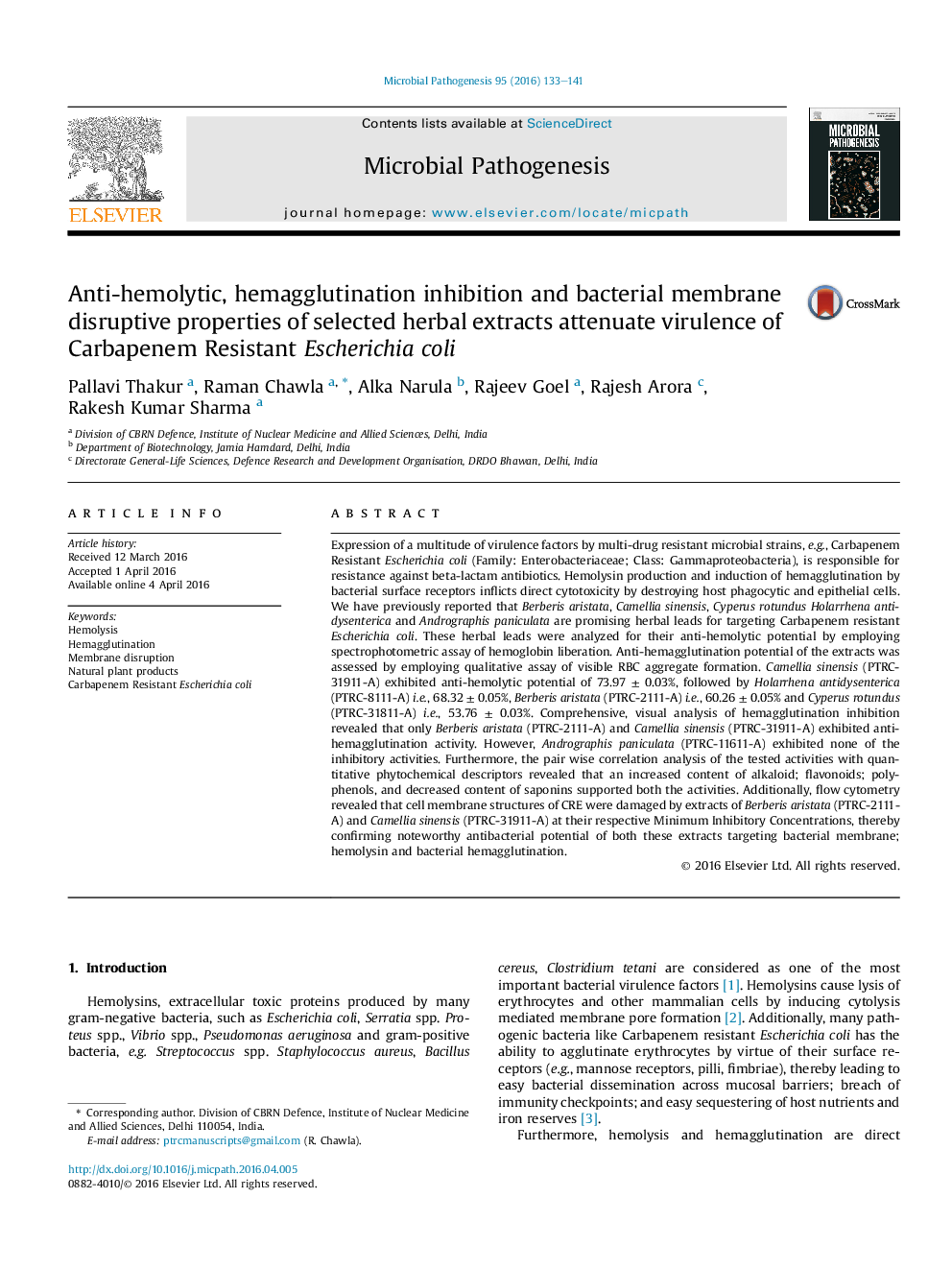| کد مقاله | کد نشریه | سال انتشار | مقاله انگلیسی | نسخه تمام متن |
|---|---|---|---|---|
| 3416249 | 1593694 | 2016 | 9 صفحه PDF | دانلود رایگان |
• Hemolysis, Hemagglutination and bacterial membrane are virulence descriptors of Carbapenem Resistant Escherichia coli.
• Camellia sinensis, Holarrhena antidysenterica, Berberis aristata and Cyperus rotundus showed anti hemolytic activity.
• B. aristata and C. sinensis exhibited anti hemagglutination activity.
• B. aristata and C. sinensis possess membrane disruption potential.
• Presence of alkaloids, flavonoids and polyphenols supported antibacterial activities.
Expression of a multitude of virulence factors by multi-drug resistant microbial strains, e.g., Carbapenem Resistant Escherichia coli (Family: Enterobacteriaceae; Class: Gammaproteobacteria), is responsible for resistance against beta-lactam antibiotics. Hemolysin production and induction of hemagglutination by bacterial surface receptors inflicts direct cytotoxicity by destroying host phagocytic and epithelial cells. We have previously reported that Berberis aristata, Camellia sinensis, Cyperus rotundus Holarrhena antidysenterica and Andrographis paniculata are promising herbal leads for targeting Carbapenem resistant Escherichia coli. These herbal leads were analyzed for their anti-hemolytic potential by employing spectrophotometric assay of hemoglobin liberation. Anti-hemagglutination potential of the extracts was assessed by employing qualitative assay of visible RBC aggregate formation. Camellia sinensis (PTRC-31911-A) exhibited anti-hemolytic potential of 73.97 ± 0.03%, followed by Holarrhena antidysenterica (PTRC-8111-A) i.e., 68.32 ± 0.05%, Berberis aristata (PTRC-2111-A) i.e., 60.26 ± 0.05% and Cyperus rotundus (PTRC-31811-A) i.e., 53.76 ± 0.03%. Comprehensive, visual analysis of hemagglutination inhibition revealed that only Berberis aristata (PTRC-2111-A) and Camellia sinensis (PTRC-31911-A) exhibited anti-hemagglutination activity. However, Andrographis paniculata (PTRC-11611-A) exhibited none of the inhibitory activities. Furthermore, the pair wise correlation analysis of the tested activities with quantitative phytochemical descriptors revealed that an increased content of alkaloid; flavonoids; polyphenols, and decreased content of saponins supported both the activities. Additionally, flow cytometry revealed that cell membrane structures of CRE were damaged by extracts of Berberis aristata (PTRC-2111-A) and Camellia sinensis (PTRC-31911-A) at their respective Minimum Inhibitory Concentrations, thereby confirming noteworthy antibacterial potential of both these extracts targeting bacterial membrane; hemolysin and bacterial hemagglutination.
Figure optionsDownload as PowerPoint slide
Journal: Microbial Pathogenesis - Volume 95, June 2016, Pages 133–141
